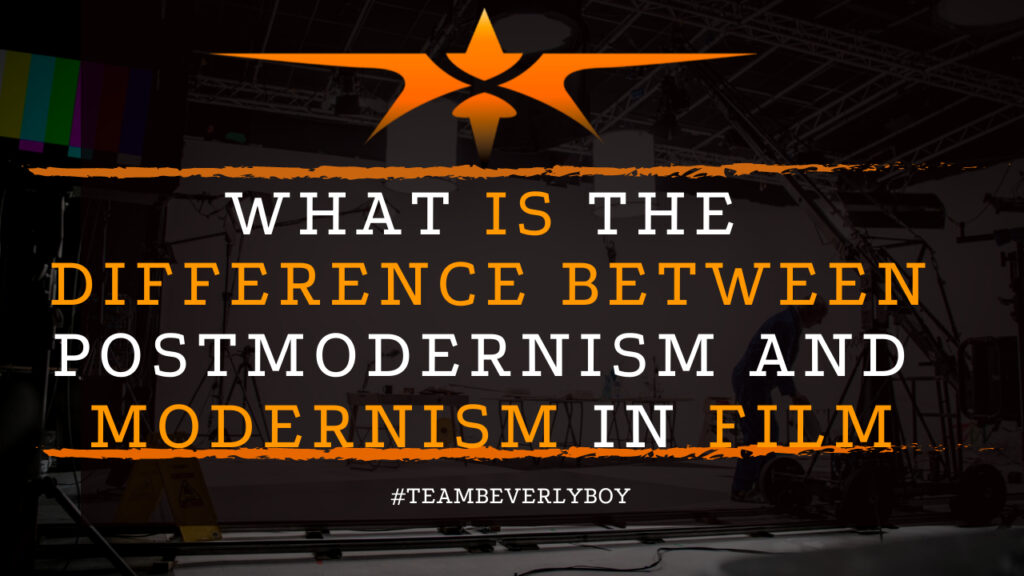What is the Difference Between Postmodernism and Modernism in Film?
While it can be challenging to define a clear definition of modernism vs. postmodernism in film, the literary devices that surround both of these particular cultural currents and expressions in filmmaking can be differentiated based on specific factors relative to each. So, what is the difference between postmodernism and modernism in film and how can a spectator recognize one or the other? While establishing a clear definition might be difficult, establishing the key differences between the two is not so hard.

WHAT IS THE DIFFERENCE BETWEEN POSTMODERNISM AND MODERNISM?
Modernism and postmodernism in film have several differences. Primarily, postmodernism describes a particular movement which was developed in the late 20th century focusing around architecture, philosophy, the arts, and criticism. Unlike postmodernism, modernism represented a period of cultural movement in which focused on certain assumptions of reason.
Essentially, modernism represented an enlightenment era or culture of truth in which reason and science were used to provide accurate, objective, and reliable knowledge. Likewise, postmodernism focused on the post-truth or in other words, recognizing the reason and science are just two ideologies created by man in which there are others too.
According to a modernist thought process, reason is independent of our existence, and historical and cultural context. Thus reason is universal and true. However, postmodernism differs in that according to postmodernism reason itself is a Western ideology that competes with other traditions including faith or other cultural means of understanding or knowing.
MODERNISM IN FILM

The concept of modernism in film references time, everyday life, and the perception of everyday occurrences. As a film plays out, the modernism period is represented by everyday life.
Providing a kaleidoscopic or otherwise fractured experience of urban space. Modernism in film will break away from tradition which tends to focus on experimenting with the old social norms.
ACCORDING TO PAST STUDIES, MODERNISM IN LITERATURE AND FILM WOULD HAVE THE FOLLOWING:
- Formalism
- Symbolism
- Absurdity
- Experimentation
- Individualism
UTOPIAN VISIONS
Modernism in film is openly concerned with a utopian vision of life. In which experimentation and the collapse of old social norms or behavioral norms are represented.
Essentially, modernism represents a belief in progress in which there are universal truths that everyone embraces and accepts.
Language is transparent and there is the existence of a stable self that is independent of culture and society as a whole.
THE FOLLOWING FILMS ARE MODERNIST OR REPRESENT MODERNISM:
- La Dolce Vita
- 8 ½
- The Naked City
- Two Happy Hearts
- The Mirror
- Rebecca
POSTMODERNISM IN FILM
In examining the difference between postmodernism and modernism in film it’s important to first understand how each of these classifications work.
Postmodernism in film articulates the mainstream conventions of narrative structure and characterization testing the audience’s suspension of disbelief.
These types of films attempt to break the cultural divide. Opening up stereotypical portrayals of gender, race, genre, class, time and other elements along the way.
IN REACTION TO
Postmodernism in film emerged as a reaction to modernism. Such that it represented an attempt to resist or otherwise differ from modernism thought processes.
Postmodernism does not reflect faith in master narratives as they apply to culture, history, or the self.
Instead, postmodernism examines multiple points of view. Representing an ambivalence toward realism and running “against the grain.”
A PHILOSOPHICAL MOVEMENT
Postmodernism represents a philosophical movement. In which there is an attitude of rejection toward narratives that are typically, and otherwise, accepted.
Postmodernism criticizes long-held beliefs and traditions. In support of viewing the world in a slightly more detached manner in which there is a non-linear story.
Postmodern films challenge common-held truths. A parody is another means of stating that a film is postmodern.
But a postmodern film is not always a parody film nor is a parody film always postmodern.
POSTMODERNISM IN FILM IS GOING TO HAVE THE FOLLOWING CHARACTERISTICS:
- Irony
- Hyperreality
- Unpredictability
- Distortion of time
- Themes of paranoia
- Magical realism
- Pastiche
SOME DIFFICULTIES
It might be difficult to define postmodernism or to specifically state that a film is using postmodernism techniques.
THE FOLLOWING FILMS HAVE POSTMODERN CHARACTERISTICS:
- Monty Python and the Holy Grail
- Blade Runner
- Austin Powers in Goldmember
- Scream
WHAT IS THE DIFFERENCE BETWEEN POSTMODERNISM AND MODERNISM IN FILM?

As you can see, there are a variety of differences between postmodernism and modernism in film.
Modernism films were largely representative of the timeframe that occurred between WWI and WWII.
Which brought forth film characteristics such as the montage and symbolic imagery. As well as surrealism and expressionism.
Likewise, postmodernism was a reaction to modernism which brought about an entirely different approach.
NARRATION
Modernism films typically used an unreliable narrator. Whereas a postmodernism film would frequently include an iconic narrator.
Postmodern films would often incorporate literature that was open and intertextual in nature whereas the literature of a modernism film was self-contained.
NARRATION
So, what is the difference between postmodernism and modernism in film?
Postmodernism in film represented the mixing of high and low-brow genres, as well as the ambivalence towards realism which was almost entirely different from modernism.
There were many other differences between the two film types. Which would continue to evolve as postmodernism sought to find ways of doubling up to fight against.
Or otherwise provide rejection against the modernism that was so popular in prior years.

